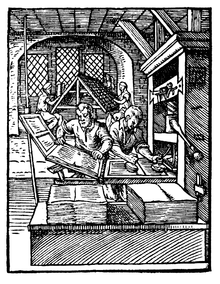“What emerges from the 16th century is a reading public ready to invest in printed material from broadsheets to pamphlets to books that went beyond their trade or devotional lives.”

http://en.wikipedia.org/wiki/Printing_press
Over the 16th century, the publishing market was refined: news pamphlets recorded local news in addition to foreign sensationalized news, sensations were the stock and trade of publishers, and collections of serial events over time.
This shift opened up the market for business.
News of crime and sensationalized stories were the primary crop in the 16th century with presses spreading news further. Their output rose from an estimated 150 to 200 million copies.
The importance of printing was further enhanced by other inventions of the time, namely firearms and the nautical compass. In 1620, Francis Bacon wrote that these inventions “changed the whole face and state of the world”.
In Renaissance Europe, the arrival of mechanical movable type printing introduced mass communication, which altered the very fabric of society. The almost unrestricted circulation of information and revolutionary ideas captured the masses and threatened the power of authorities.
Additionally, the vast increase of literacy severed the division between the literate elite and the emerging middle class. Across Europe, increasing cultural self-awareness was accelerated by the advancement of the European vernacular languages.

Leave a response